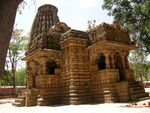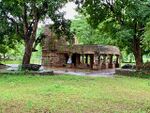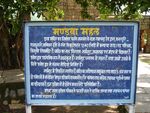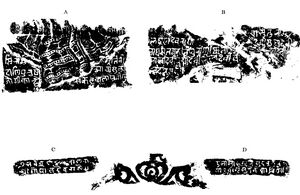Phani Naga
| Author: Laxman Burdak, IFS (R) |
Phani Naga (फणी नाग) was a Nagavanshi Jat ruler in Chhattisgarh.
Variants
- Phaninaga (फणी नाग)
- Fani Naga (फणी नाग)
- Faninaga
- Phani Naga dynasty
- Phani Nagavanshi
Origin
Jat clans
- Fandi/Fanin are descendants of Phani Naga.
History
The Nagas of Kawardha established their power in the 9th century AD and they continued their rule till the middle of 14th century AD as feudatory of Kalachuris of Ratanpur. Details about this dynasty has been supplied by nine Inscriptions found at Kawardha, Chhapri, Chaura, Pujaripali, Boria and Sahaspur.[1]
Bhoramdeo
Bhoramdeo (भोरमदेव) is a Temple complex dedicated to Shiva at Chaura village in Bodla tehsil of Kawardha district in Chhattisgarh. [2] It comprises a group of four temples of which the earliest is a brick-temple.[3] The Temple was built by Laxman Dev Rai & Gopal Dev of Phani Naga dynasty. Temple complex, highlighted as a "scintillating poetry in stone", is credited to Naga kings of Chakrakota, who ruled in the then South Kosala region, which is now the state of Chhattisgarh. Its construction is dated between the 7th and 12th centuries.[4] Chakrakuta is variant of Chitrakuta in Bastar[5], which was a Kingdom Nagavanshi Jats. [6] Fandi or Fanin Gotra Jats are descendants of Phani Naga. Author (Laxman Burdak) visited it on 16.04.1985 while on way from Raipur - Jabalpur.
The main temple is the Bhoramdeo temple built in stone. The architectural features with erotic sculptures has given a distinct style akin to the Khajuraho temple and the Konark Sun Temple in Odisha, and hence the Bhoramdeo complex is known by the sobriquet the "Khajuraho of Chhattisgarh".[7]
Another temple within a distance of about 1 km from Bhoramdeo, which is mentioned along with the Bhoramdeo complex is the Madwa Mahal, meaning marriage hall in local dialect, also known as Dullhadeo. It was built in 1349 during the reign of Ramchandra Deo of the Naga dynasty of Kawardha and has a unique Shiva Linga erected over 16 pillars.[8]
The temple complex, rich in history and archeological details, is dated to the Kalachuri period (10th-12th centuries, one ruling over areas in Central India in west Madhya Pradesh, Rajasthan and were called Chedi or Haihaya (Heyheya) (northern branch) with close identity with the sculptures found in nearby archeological sites such as Janjgir, Kalachuri, Narayanpur and Ratanpur sites. The brick temples were built during the rule of Pandus and are similar to those built in Kharod, Palari, Rajim and Sirpur in the state.[9]
The Temple was built by Laxman Dev Rai & Gopal Dev of Phani Naga dynasty. Temple complex, highlighted as a "scintillating poetry in stone", is credited to Naga kings of Chakrakota who practiced tantrism and who ruled in the then South Kosala region, which is now the state of Chhattisgarh. Its construction is dated between the 7th and 12th centuries.[10] As the Gond Tribals of the area worshiped Lord Shiva whom they called Bhoramdeo, the temple was also named Bhoramdeo with the Shiva Linga deified in it.[11]
Chhapri Statue Inscription of Gopaladeva (Kalachuri) year 840 (1048 AD)
These inscriptions were first brought to notice by Sir A Cunningham who published transcripts of them together with a photozincograph in bis Archœological Survey of India Reports, Vol XVII (1881-82), pp 34 ff and plate xxii. They were subsequently noticed by Rai Bahadut Hiralal in his Inscriptions in C P and Berar. They are edited here from estampages kindly supplied by Mr M A Suboor of the Central Museum, Nagpur.
The inscriptions are incised on the pedestal of a large statue. The temple of Boramdeo, in which the inscribed statue is now placed, is situated at the western end of a long embankment which forms a lake in the valley near Chhapri, 11 miles east of Kawardha, in the Chhattisgarh Division of Madhya Pradesh. The statue is of a bearded man sitting with folded hands, and measures 2'-7" high and 1' 11" broad. On its pedestal is figured a Raja on horseback with an attendant carrying an umbrella and a female offering food to the horse. To the right is a Jogi seated with knees bound.
The inscriptions are four in number. Two of them, called here A and B, are divided by the dress of the statue into two parts. The characters of all are Nagari of about the eleventh century A C. The average size of the letters is 4"
|
A १. स्रि(श्री)राम - मूर्ति वी - २.दाणि पुरुषा- त्मा वासुल - ३. जोगी कान्हो सकलकलाप्रवीणु(ण) [।*] B १. लषणदेवरायो वासु[ल]रामु २. रायमतगज सिघुराणी माता- देवी सुधा देवी ३. रातादेवी पद्मादेवी [सी]लादेवी वा- तादेवी ४. नदतु सकु C १. सिद्धि [।*] संवत ८४० राणक २.श्री गोपालदेवराज्ये ॥ D १. उमा माहेस्व[र] सुन्दरतरं २. साधु धागुसुतेन कारितं |
| Chhapri Statue Inscription of Gopaladeva (Kalachuri) year 840 (1048 AD)[12] |
The language is Sanskrit. The only orthogtaphical peculiarity that calls for notice is the use of sh for kh (representing the Sanskrit kshma) in Lashanadêvaràyô inL-1 of B.
The first of these inscriptions (A) names Jôgï Kânhô and describes him as proficient in all arts and as a human incarnation of the illustrious Rama. He is evidently the personage whom the statue was intended to represent. Cunningham took him to be identical with the Jôgï figured on the pedestal of the image and thought that he was the religious adviser of the Râjâ on horseback, whom he considered to be the builder of the temple. The second inscription (B) gives the names of the king Lakshmanadeva and his crowned queen, son and daughters. The third record (C) gives the date as Samvat 840 (expressed in decimal figures only) during the reign of the Rānaka, the illustrious Gopāladeva, while the last one (D) states that the very beautiful image of Umā-Mahesvara was caused to be made by Sādhu, the son of Dhāngu.
The date of the inscription must, on palœographic grounds, be referred to the Kalachuri era and would correspond to 1048-49 A.C. It does not admit of verification. The use of the Kalachuri era suggests that Gopāladeva was a feudatory of the Kalachuri ruler of Ratanpur. It may be noted in this connection that some other inscriptions in and near the temple of Boramdeo, dating from the 14th to the 16th century A. C. , are recorded in the Vikrama era. Lakshmanadeva seems to have been a petty chief under Gôpàladëva.
The temple of Boramdeo has been praised by Cunningham as one of the most richly decorated temples that he had seen. It is so called because it was used in later times by the Gonds for the worship of their god. The sanctum of the temple contains at present an image of the snake-god besides a Siva-Linga; but from the figure of Vishnu over the middle of the three entrances of the temple, Cunningham conjectured that it was originally dedicated to Vishnu. He actually found under a tree a few paces to the eastward a sculpture, figuring Vishnu and Lakshmi sitting on Garuda. Inscription D, however, refers to an image of Umâ-Mahësvara. Perhaps the statue, on which these inscriptions are incised, was originally put up at some other temple dedicated to Umâ-Mahësvara. It may be noted in this connection that Cunningham has described another old temple situated to the north of the temple of Boramdeo, the sanctum of which contains in addition to an argha in situ, a small group of Hara-Gauri. It is perhaps this latter image which is mentioned in inscription D.
Translation
A
The excellent Jogi Kānhô, the present incarnation, in human form, of the illustiious Rāma, who is proficient in all arts.
B
The king Lakshmanadêva, the excellent Rāma, the elephant-like king, the queen mother Singhurāni, the princess Sudhā, the princess Rātā, the princess Padmā, the princess Sīlā, the princess Vātā — May (these) be able to rejoice !
C
Success ! In the year 840, during the reign of the illustrious Gopāladeva.
D
The very beautiful (images of) Umā and Mahesvara have been caused to be made by Sādhu, the son of Dhāngu.
Notes by Wiki Editor
- Saka era - The inscription refers the Saka era and not the Kalachuri era as indicated.
- Jogi Kānhô - Name and style indicates its Rajasthani origin as nouns end in 'o' in Rajasthani language.
- Gopaladeva - See the ancestry of Nagavanshi rulers in Kawardha. Gopaladeva is mentioned at S.No. 6. He must be an independent ruler and not a feudatory of Kalachuri rulers of Ratanpur.
- Rānaka - Seems title and needs further research
- The period of Inscription 1048 AD is contemporary of Nagavanshi rulers ancestors of Tejaji (1074- 1103 AD) in Nagaur district of Rajasthan.
- Chhapri - Villages of this name are also found in Rajasthan in and Madhya Pradesh:
- Barmer tahsil in Barmer district
- Bhilwara tahsil in Bhilwara district
- Kapasan tahsil in Chittorgarh district
- Phagi and Phulera tahsils in Jaipur district.
- Chhapri Kalan (छापरी कलां), Chhapri Khurd (छापरी खुर्द) in Didwana in Nagaur district
- Alot (आलोट) tahsil in Ratlam district in Madhya Pradesh.
- Tarana (तराना) tahsil in Ujjain district in Madhya Pradesh.
This shows us about the movement of these people from Rajasthan to Malwa in Madhya Pradesh and then to Kawardha.
Boramdeo Temple (Chhapri-Kawardha) Inscriptions 1088 A.D.
Near the village Chhapri, 11 miles east of Kawardha, there is an old temple of Vishnu, popularly known as Boramdeo, on account of Gonds having utilized it as a shrine of their god when they were ascendant. The oldest inscription here is on the pedestal of a large figure of a bearded man sitting with joined hands, which General Cunningham considered to be the Raja's religious adviser. There are four records on it. The first gives a number of names apparently of the temple builder's religious advisers. In the second inscription the names of his wife, sons and daughters are given, In the third the date is given as 840, during the reign of Gopaladeva, and the fourth gives the names of masons.
The year apparently belongs to the Kalachuri era, and is thus equivalent to 1088 A.D. Gopaladeva was evidently a local chief under the sovereignty of the Ratanpur kings. He may be identical with Gopaladeva of the Pujaripali inscription. The principal image of the temple is that of Lakshmi Narayana, on the pedestal of which the name of that ubiquitous Jogi Magaradhvaja with the figure 700 is inscribed. On the wall of the temple there is a modern inscription of the Samvat year 1608 (A. D. 1551), which was originally read as 160, equivalent to A.D. 103, and was quoted as a proof of the antiquity of Gond rule in Chhattisgarh.
Source - (Cunningham's Archaeological Reports, Volume XVIII, page 42.)
Mandava Mahal Inscription of Ramachandra of Phani Nagavanshi kings of Samvat 1406 (A. D. 1349) at Chaura
Source - Hira Lal: Descriptive lists of inscriptions in the Central provinces and Berar,p.162-63
Chaura is a village about 11 miles from Kawardha. In a temple known as Mandava Mahal (मंडवा महल) there is a long inscription on a slab containing 37 lines, which records the construction of a Siva temple by king Ramachandra, born of the Phani or Nagavansha, and married to Ambikadevi of the Haihaya lineage. It gives the legend of the origin of the Nagavansha, somewhat resembling that of the Haihaya-vansha, who claim a serpent and a mare to be their original ancestors. Our record relates that a serpent got enamoured of Mithila, the beautiful daughter of the sage Jatukarna (जाटुकर्ण).
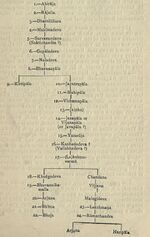
He therefore assumed human form and had intercourse with her. Their issue was Ahiraja, who, having conquered the neighbouring chiefs, set himself up as a king. The kings who followed him are shown in the genealogical table in the picture. Family tree is as under:
1. Ahiraja → 2. Rajalla → 3. Dharnidhara → 4. Mahimadeva → 5. Sarvavandana (Saktichandra ?) → 6. Gopaladeva → 7. Naladeva → 8. Bhuvanapala → 9. Kirtipala → 10. Jayatrapala → 11. Mahipala → 12. Vishamapala → 13. Ja(nhu) → 14. Janapala or Vijanapala (or Juvapala ?) → 15. Yasoraja → 16. Kanhadadeva ? (Vallabhadeva ?) → 17. (La)kshmavarma → 18. Khadgadeva → 19. Bhuvanaikamalla → 20. Arjuna → 21. -Bhima → 22. Bhoja
17. (La)kshmavarma → Chandana → Vijjana → Malugideva → 23 Lakshrtiana → 24. Ramachandra → (Arjuna + Haripala)
It would appear that the succession deflected twice from the direct line. For nine generations up to Kirtipala it went in a direct line. The 10th king Jayatrapala was a brother of Kirtipala, who apparently had no son to succeed him. Twelve descendants of Jayatrapala succeeded one after the other, the last king Bhoja being succeeded by Lakshmana, a great-grandson of his great-great-grand-uncle. Lakshmana's son was Ramachandra, the 20th descendant from the original ancestor Ahiraja.
The inscription is dated in Vikrama Saka 1406, bearing the name Jaya, which makes it clear that the year intended was that of the Vikrama era, as the cyclic year Jaya was current in Vikrama Samvat 1406 (A. D. 1349).
This record shows that Kawardha and the neighbouring country were under the sway of the Nagavanshi Jats for a period of about 500 years, commencing from the beginning of the 9th Century A. D., a little before the advent of the Kalachuris or Haihayas to Chhattisgarh.
Apparently the Nagavanshi Jats became the feudatories of the Kalachuris and continued to rule under their protection for a long time. Amongst the kings of this dynasty we find two names Gopaladeva (6) and Yasoraja (15) with which we are familiar from other inscriptions found in this locality. Gopaladeva's name occurs in the Boramdeo temple, about a mile away from our inscription slab. It is dated in the Kalachuri year 840, or A. D. 1088, while at Sahaspur, only 21 miles away from Chaura, there is a record of Yasoraja, dated in the Kalachuri year 934, or A.D. 1182. These kings must evidently belong to the dynasty which our record describes. Between Gopaladeva and Yasoraja there was an interval of only 94 years according to the dates of their inscriptions, but our record gives eight intervening generations, giving an average of less than 12 years to a generation. This throws a doubt on the accuracy of the genealogy, to swell which it is possible a number of fictitious names may have been inserted.
The geographical names mentioned in the record are Chavarāpura, the Samkari river, Rajapura and Kumbhipuri.
Chavarapura, to the east of which the temple was built, is undoubtedly the village Chaura, within whose limits the temple still lies, and Samkari is the Sankari river which is about a quarter of a mile away.
Rajapura was a village granted for the supply of offerings to the god, and may be identified with a village of the same name three miles from Chaura.
Kumbhipuri is not traceable. It was given at the same time as an agrahara to a Brahman named Mahesa.
The record which is in verse, was composed by a Dakshini Brahman Vitthala, which seems to account for the curious way in which he has indicated the era, calling it Vikrama Saka ; the last word Saka used in this phrase is merely an equivalent of a year.
फणीनागवंश
भोरमदेव मंदिर: कबीरधाम जिला 11वी शताब्दी के फणीनागवंशी काल में निर्मित भोरमदेव मंदिर की पहचान विश्व पर्यटन मानचित्र पर रेखांकित हो रही है।भोरमदेव मंदिर जिला मुख्यालय कवर्धा से उत्तर पश्चिम में 18 किलोमीटर की दूरी पर सतपुड़ा मैकल पहाड़ियों के पाद तल में बसे हुए चौरा गांव में स्थित है। भोरमदेव मंदिर का निर्माण फणी नागवंश के छठवें राजा गोपाल देव द्वारा 11 वीं शताब्दी 1087 ई में कराया गया था। मंदिर में बनाए गए तीन प्रवेश द्वार जो तीनों की आकृति अर्द्ध मंडप जैसी ही दिखाई देती है। इस मंदिर मंडप में 16 स्तंभ तथा चारों कोनों पर चार अलंकृत भित्ति स्तंभ है। मंदिर के वर्गाकार गर्भगृह में हाटकेश्वर महादेव विशाल जलाधारी के मध्य प्रतिष्ठित है। गर्भगृह में ही पद्मासना राजपुरूष सपत्नीक,पदमासना सत्पनीक ध्यान मग्य योगी,नृत्य गणपति की अष्ठभूजी प्रतिमा तथा फणीनागवंशी राजवंश के प्रतीक पांच फणों वाले नाग प्रतिमा रखी हुई है। काले भूरे बलुआ पत्थरों से निर्मित मंदिरी की वाहय दीवानों पर देवी देवताओं की चित्ताकर्षक एवं द्विभुजी सूर्यप्रतिमा प्रमुख है। मंदिर के वाह्य सौंदर्य दर्शन का सबसे उपयुक्त स्थल ईशान कोण अर्थात भोरवदेव के ठीक सामने है, यहां से मंदिर रथाकार दिखाई देखता है। यह मंदिर तल विन्यास से सप्तरथ चतुरंग,अंतराल,अंलकृत, स्तंभों से युक्त वर्गाकार मण्डप है। उध्र्व विन्यास में उधिष्ठान जंघा एवं शिखर मंदिर के प्रमुख अंग हे। मंदिर के जंघा की तीन पंकित्यों में विभिन्न देवी देवताओं की कृष्णलीला, नायक-नायिकाओं, अष्ठद्विकपालों, युद्ध एवं मैथुन दृष्यों में अलंककरण किया गया है।
References
- ↑ excavations in central India: Madhya Pradesh and Chhattisgarh By R. K. Sharma, Om Prakash Misra, p. 15
- ↑ Syed Amanur Rahman; Balraj Verma (2006). The Beautiful India – Chhatisgarh. Reference Press.
- ↑ Deshpande, M.N. "Indian Archeological Survey – 1972-73" (PDF). National Informatics Center. pp. 13–14. Archived from the original (pdf) on 2016-03-04.
- ↑ Ramaswamy, Chitra (12 April 2012). "Sheer poetry in stone". The Hindu.
- ↑ Epigraphia Indica & Record of the Archaeological Survey of India, Vol.X, 1909-10, p.28
- ↑ Jat History Dalip Singh Ahlawat/Chapter III, p.242
- ↑ https://web.archive.org/web/20091125135517/http://kawardha.nic.in/bhoramdeo.htm
- ↑ https://web.archive.org/web/20091125135517/http://kawardha.nic.in/bhoramdeo.htm
- ↑ Deshpande, M.N. "Indian Archeological Survey – 1972-73" (PDF). National Informatics Center. pp. 13–14. Archived from the original (pdf) on 2016-03-04.
- ↑ Ramaswamy, Chitra (12 April 2012). "Sheer poetry in stone". The Hindu.
- ↑ Ramaswamy, Chitra (12 April 2012). "Sheer poetry in stone". The Hindu.
- ↑ Corpus Inscriptionium Indicarium Vol IV Part 2 Inscriptions of the Kalachuri-Chedi Era, Vasudev Vishnu Mirashi, 1905, p. 581
Back to The Ancient Jats
